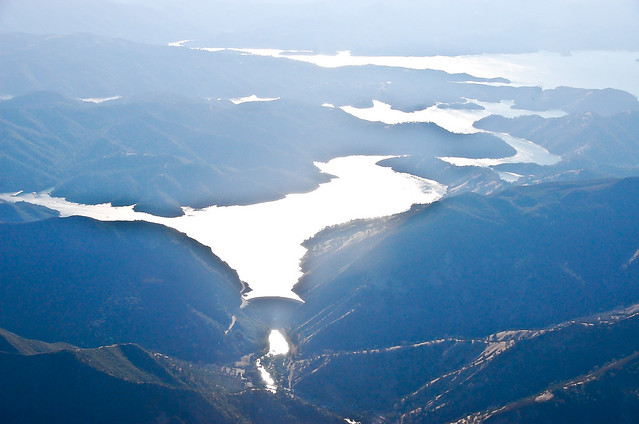Lake Berryessa's 160+ miles of coastline hosted over twenty resorts (only a few are open now, and under a temporary agreement, at that...). Of specific interest is the Spanish Flats resort, which is my personal favorite, and the impetus for all this research.
Spanish Flats operated under a (fifty year) lease agreement with the Bureau of Reclamation, and that lease expired recently. According to an inspection report prepared by BoR, many of the resort's basic infrastructure and services (like, sewage treatment, potable water, electricity, etc) were highly stressed or in poor repair:
There is one evaporation pond. The pond is oval, approximately 45’ wide and 150’ long. Weeds are prevalent throughout the pond. There was an excess amount of algae and odor observed during our inspection. The mister spray system has been disconnected, possibly due to the high winds at this location and the potential for human contact by the wastewater. The maintenance man did not know where the pond inlet was located. A plugged AC pipe was the only potential inlet pipe that we could find. The wastewater retention pond is undersized for the current resort wastewater is not disinfected, and the potential for human pathogenic contact is very high.Napa County prepared a good summary (PDF) of some of the issues with Spanish Flats (at least, in the County's eyes):
Commercial services in these communities have diminished since the 1970s, even though the lake itself and shoreline areas leased by the BOR to concessionaires continue to attract recreational users year-round.One of the companies BOR is negotiating with is Pensus Group, a company that manages several lakeside resorts all over the US. (including a resort on Lake Powell, which as you can see from this series of NASA images, is not doing too well...) Pensus was actually awarded a contract, but objections to a legal stipulation requiring all site upgrades to be removed (like water piping, roads, sewage, etc) have impeded the development process:
...under-utilized parcels zoned for commercial use, and others zoned for multi-family residential (affordable or workforce) housing. Property owners have not shown an interest in building-out these permitted uses, perhaps due to infrastructure costs.
...Within the next few years, the BOR will negotiate new concession agreements for resorts within its jurisdiction, potentially changing the character and clientele of some of the resorts.
More recently, resort owners have been told they must remove every improvement made to the properties since the original contracts were signed. This includes buildings, water and sewage systems, and even the blacktop roads through the resorts.A question that comes to mind has to do with eminent domain. Specifically, could the State of California make an eminent domain claim to Lake Berryessa, thus relieved the Federal Gov't of management/policy/oversight, and returning it to some degree of local control? Would that benefit the state and citizens demonstrably? Would it be worth the effort and frustration? Wikipedia says:
Lucero said before a new tenant can take over the resorts, the current properties must be cleared. Pensus, for example, plans to build hotels, day-use areas, restaurants and other improvements, he said.
Source: Danny Bernardini, The Reporter, Vacaville
The U.S. Supreme Court has consistently deferred to right of states to make their own determinations of public use. For instance, in 1832 the Supreme Court ruled that eminent domain could be used to allow a mill owner to expand his dam and operations by flooding an upstream neighbor. The court opinion stated that a public use does not have to mean public occupation of the land; it can mean a public benefit.[3] In Clark vs. Nash (1905), the Supreme Court acknowledged that different parts of the country have unique circumstances and the definition of public use thus varied with the facts of the case. It ruled a farmer could expand his right-of-way (here an irrigation ditch from a river) across another farmer's land (with compensation), because that farmer was entitled to the "the flow of the waters of the said Fort Canyon Creek... and the uses of the said waters... [is] a public use." Here in recognizing the arid climate and geography of Utah, the Court indicated the farmer not adjacent to the river had as much right as the farmer who was, to access the waters.[4] However, until the 14th Amendment was ratified in 1868, the limitations on eminent domain specified in the Fifth Amendment applied only to the federal government and not to the states. That view ended in 1896 when in the Chicago B. & Q. Railroad v. Chicago case the court held that the eminent domain provisions of the Fifth Amendment were incorporated in the Due Process Clause of the Fourteenth Amendment and thus were now binding on the states. This was the beginning of what is known as the "selective incorporation" doctrine.But that doesn't fully answer the question: Can a State invoke eminent domain and seize property *from* the Federal Gov't?
And why would we go through all that trouble?

No comments:
Post a Comment